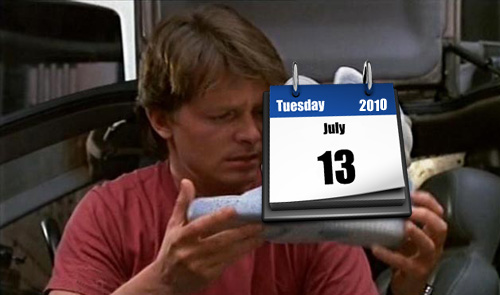6 Easy Steps to Pulling Off Your Own Back to the Future Hoax

Last week a picture popped up on the Internet celebrating the fact that July 5, 2010 was the date in Back to the Future II when Marty McFly arrived from the... we'll say "present." Apparently this picture delighted everyone who saw it, because they began passing on the news to all their friends and families via Twitter and Facebook and Google Buzz and Yahoo! WhateverTheFuck. And the story would have ended there, if it turned out that they weren't all completely wrong, taken in by a fraudulent photograph.
 Actor Michael J. Fox, seen here in a publicity still from Back to the Future 2.
How could so many people be wrong about something all at once? Even for Internet users, this is pretty bad. Surely someone must have noticed that the date was a phony, some desperate sweaty soul, who had memorized the Back to the Future canon to an unhealthy degree. And the thing is, there probably were a lot of people out there who did notice the problem, and corrected people when they saw them spreading the erroneous date. But because these corrections were small and wienery and lacked photographic evidence, they were powerless to stop the original hoax from spreading--like trying to hold back a charging rhino with an uncooked hot dog.
Actor Michael J. Fox, seen here in a publicity still from Back to the Future 2.
How could so many people be wrong about something all at once? Even for Internet users, this is pretty bad. Surely someone must have noticed that the date was a phony, some desperate sweaty soul, who had memorized the Back to the Future canon to an unhealthy degree. And the thing is, there probably were a lot of people out there who did notice the problem, and corrected people when they saw them spreading the erroneous date. But because these corrections were small and wienery and lacked photographic evidence, they were powerless to stop the original hoax from spreading--like trying to hold back a charging rhino with an uncooked hot dog.
 Now I could stand up here on my Internet soapbox and strip down to my Orating Shorts and point out that poorly researched hearsay isn't very accurate. But that's kind of obvious, and not terribly useful information, even considering the low bar for usefulness that this column maintains. A discussion of how the high expectations for social media's potential keep violently colliding with the sheer ineptness of social media practitioners would actually be useful--though probably too useful, this time considering this column's audience of largely illiterate day-laborers. Instead I decided to analyze this incident and hoaxes in general, to build a template which you could use to publish your own Internet hoaxes--which I am imploring you to enjoy on an entirely academic level, unlike that article on "The 8 Wackiest Ways to Kite Checks" which got me in a lot of trouble last year. Behave yourselves you little monsters.
____
How to make your own Internet Hoax
Step 1: Get your victims to do all the heavy lifting
This is an important step, because powerful though you might be, you will not be able to spread this hoax all by yourself.
Now I could stand up here on my Internet soapbox and strip down to my Orating Shorts and point out that poorly researched hearsay isn't very accurate. But that's kind of obvious, and not terribly useful information, even considering the low bar for usefulness that this column maintains. A discussion of how the high expectations for social media's potential keep violently colliding with the sheer ineptness of social media practitioners would actually be useful--though probably too useful, this time considering this column's audience of largely illiterate day-laborers. Instead I decided to analyze this incident and hoaxes in general, to build a template which you could use to publish your own Internet hoaxes--which I am imploring you to enjoy on an entirely academic level, unlike that article on "The 8 Wackiest Ways to Kite Checks" which got me in a lot of trouble last year. Behave yourselves you little monsters.
____
How to make your own Internet Hoax
Step 1: Get your victims to do all the heavy lifting
This is an important step, because powerful though you might be, you will not be able to spread this hoax all by yourself.
 "Hey Internet! I dare you to post your address. Because I will come there and beat you up."
Back in the old days, hoaxes were spread by people forwarding emails to each other, because that's all we had back then. (We were just constantly forwarding emails about hoaxes and looking at GIFs of pornography actresses on our Netscape Navigators.) It worked; clicking a forward button is easy, but there was always that complicated address list to fill in, which slowed slower people down. In the modern days we've reduced the sharing of trivial information to a one click operation, with tools like Twitter which had reduced internet communication to a level that can apparently be used by cats.
Example Hoax Vector: Oprah's forums
Not a lot of people know this about me, but I'm also a respected moderator on the O forums, posting under the username OprahFan2. Because the Oprah forums have 68,000 active members, posting three quarters of a million times a day, it's a sufficiently high volume community that ensures once a message begins to spread, it stays spreading. By supplementing this with some throwaway Facebook and Twitter accounts, I should ensure adequate coverage for my hoax.
____
Step 2: Pick a subject that everyone knows, but not that well.
There was a great Twitter hoax that made the rounds awhile back about how Johnny Depp had died in a car crash. That's a great topic because everyone's heard of Johnny Depp, but very few of us can check in with him regularly. For example, I don't know where Depp is right now, or what kind of car he drives, or whether he even likes dieing in fiery wrecks. So when I see this hoax, lacking any better sources of information, my first thought would be: Oh man, that sucks. I liked Johnny Depp. I'd better tell hundreds of people about that immediately. How will they be able to properly mourn Depp's passing without knowing how I feel?
"Hey Internet! I dare you to post your address. Because I will come there and beat you up."
Back in the old days, hoaxes were spread by people forwarding emails to each other, because that's all we had back then. (We were just constantly forwarding emails about hoaxes and looking at GIFs of pornography actresses on our Netscape Navigators.) It worked; clicking a forward button is easy, but there was always that complicated address list to fill in, which slowed slower people down. In the modern days we've reduced the sharing of trivial information to a one click operation, with tools like Twitter which had reduced internet communication to a level that can apparently be used by cats.
Example Hoax Vector: Oprah's forums
Not a lot of people know this about me, but I'm also a respected moderator on the O forums, posting under the username OprahFan2. Because the Oprah forums have 68,000 active members, posting three quarters of a million times a day, it's a sufficiently high volume community that ensures once a message begins to spread, it stays spreading. By supplementing this with some throwaway Facebook and Twitter accounts, I should ensure adequate coverage for my hoax.
____
Step 2: Pick a subject that everyone knows, but not that well.
There was a great Twitter hoax that made the rounds awhile back about how Johnny Depp had died in a car crash. That's a great topic because everyone's heard of Johnny Depp, but very few of us can check in with him regularly. For example, I don't know where Depp is right now, or what kind of car he drives, or whether he even likes dieing in fiery wrecks. So when I see this hoax, lacking any better sources of information, my first thought would be: Oh man, that sucks. I liked Johnny Depp. I'd better tell hundreds of people about that immediately. How will they be able to properly mourn Depp's passing without knowing how I feel?
 Example Hoax Subject: Matt LeBlanc
You'll recall Matt from his work playing Prospero in the Royal Shakespeare Company's 1998 production of… no I'm fucking with you. He's Joey from Friends. Everyone knows him: He's the guy who made $1 million an episode playing Joey on Friends and now we all have to think about that fact for a little while.
God. Damn.
____
Step 3: Tell them what they want to hear
If your hoax is plausible enough, people will instinctively overlook any small gaps in the details and fill in the blanks themselves. That's why that Back to the Future hoax worked. When you remind someone that we live in the year two thousand and fucking ten and we walk around like it's not even a big deal, they get a little giddy. Tell someone that today's the date from Back to the Future II…
Example Hoax Subject: Matt LeBlanc
You'll recall Matt from his work playing Prospero in the Royal Shakespeare Company's 1998 production of… no I'm fucking with you. He's Joey from Friends. Everyone knows him: He's the guy who made $1 million an episode playing Joey on Friends and now we all have to think about that fact for a little while.
God. Damn.
____
Step 3: Tell them what they want to hear
If your hoax is plausible enough, people will instinctively overlook any small gaps in the details and fill in the blanks themselves. That's why that Back to the Future hoax worked. When you remind someone that we live in the year two thousand and fucking ten and we walk around like it's not even a big deal, they get a little giddy. Tell someone that today's the date from Back to the Future II…
 If you look carefully at this still from the film, you can see the date is actually today's date.
…they won't question you, they'll start thinking about how awesome the future was supposed to be and now actually isn't.
Example Hoax: Matt LeBlanc caught crapping into a cup in a Wendy's.
Here's my idea. I begin spreading a story where Matt LeBlanc visits a Santa Monica area Wendy's, asks to use the washroom and finds that it is out of order. Apparently in some distress, he then procures a cup, and poops into it discretely by the condiment counter, only to be accosted by store management and an off-duty judge.
You see what I did there? This is exactly the thing everyone's always concerned Matt LeBlanc is about to do, and by seeing it printed on the Internet in real words, people will automatically believe it.
____
Step 4: Make people feel involved
Many of the classic hoaxes and scams that gullible relatives used to clog our inboxes with were either warnings about grave dangers like insects or computers viruses, or explicit calls for sympathy, like fake charities about Nigerian banking disasters. These little hooks were set specifically to catch in the sympathy receptors of the victim's fleshy mouth, and jerk their flailing limbs around until they smacked into the keyboard and forwarded the hoax to their friends.
Example Hoax: Include a call to action in the first sentence
If you look carefully at this still from the film, you can see the date is actually today's date.
…they won't question you, they'll start thinking about how awesome the future was supposed to be and now actually isn't.
Example Hoax: Matt LeBlanc caught crapping into a cup in a Wendy's.
Here's my idea. I begin spreading a story where Matt LeBlanc visits a Santa Monica area Wendy's, asks to use the washroom and finds that it is out of order. Apparently in some distress, he then procures a cup, and poops into it discretely by the condiment counter, only to be accosted by store management and an off-duty judge.
You see what I did there? This is exactly the thing everyone's always concerned Matt LeBlanc is about to do, and by seeing it printed on the Internet in real words, people will automatically believe it.
____
Step 4: Make people feel involved
Many of the classic hoaxes and scams that gullible relatives used to clog our inboxes with were either warnings about grave dangers like insects or computers viruses, or explicit calls for sympathy, like fake charities about Nigerian banking disasters. These little hooks were set specifically to catch in the sympathy receptors of the victim's fleshy mouth, and jerk their flailing limbs around until they smacked into the keyboard and forwarded the hoax to their friends.
Example Hoax: Include a call to action in the first sentence
 ____
Step 5: Offer evidence
Because you followed Step 3, and created a hoax that everyone wants to believe, you're not going to need a lot of evidence here. And given the low barrier of entry for publishing anything on the Internet, you can easily dummy up a few pictures or populate a few pages with proof of your find. I think CNN has a "submit a story feature" which automatically links anything you type to their front page. They are such a terrible news service.
Example Hoax: We'll just make up a fake url
If anyone does click on it, when they find it doesn't work they'll just think it got truncated accidentally. Here are a couple good ones I just made up off of the of my head:
http://abcnews.go.com/WN/matt-leblanc-defecates-publicly/story?id=11439184
http://www.cnn.com/2010/SHOWBIZ/celebrity.news.gossip/07/13/matt.leblanc.crap.horror.show/index.html
http://www.tmz.com/2010/07/12/matt-leblanc-leaves-frosty-surprise-at-wendys-the-surprise-is-its-poop/
____
Step 6: Deny everything
As is their nature, eventually the hoax will get found out, and things will come to an end with hopefully no one too badly hurt, of if they are, then hilariously badly hurt. Matt LeBlanc getting his pants caught in a car door and getting dragged a short distance is sort of what I'm thinking. Maybe a tumble down an up-escalator, where he just keeps falling and falling for like a minute and a half.
Anyways, at that point, after the police have wiped the tears from their eyes, someone will ask how all this business about chasing Matt LeBlanc across three states got started, and they might start tracing back the series of links.
Examples Hoax: Pre-planning saves the day
Due to a crippling fear of both governments and space governments, I do all of my computing using multiple proxies, public wi-fi spots, 256-bit encryption and a long typing stick, all in a multi-layered attempt to protect my anonymity. Any attempts to trace me should prove fruitless, and the truth (I am Matt LeBlanc) will never be revealed.
____
____
Step 5: Offer evidence
Because you followed Step 3, and created a hoax that everyone wants to believe, you're not going to need a lot of evidence here. And given the low barrier of entry for publishing anything on the Internet, you can easily dummy up a few pictures or populate a few pages with proof of your find. I think CNN has a "submit a story feature" which automatically links anything you type to their front page. They are such a terrible news service.
Example Hoax: We'll just make up a fake url
If anyone does click on it, when they find it doesn't work they'll just think it got truncated accidentally. Here are a couple good ones I just made up off of the of my head:
http://abcnews.go.com/WN/matt-leblanc-defecates-publicly/story?id=11439184
http://www.cnn.com/2010/SHOWBIZ/celebrity.news.gossip/07/13/matt.leblanc.crap.horror.show/index.html
http://www.tmz.com/2010/07/12/matt-leblanc-leaves-frosty-surprise-at-wendys-the-surprise-is-its-poop/
____
Step 6: Deny everything
As is their nature, eventually the hoax will get found out, and things will come to an end with hopefully no one too badly hurt, of if they are, then hilariously badly hurt. Matt LeBlanc getting his pants caught in a car door and getting dragged a short distance is sort of what I'm thinking. Maybe a tumble down an up-escalator, where he just keeps falling and falling for like a minute and a half.
Anyways, at that point, after the police have wiped the tears from their eyes, someone will ask how all this business about chasing Matt LeBlanc across three states got started, and they might start tracing back the series of links.
Examples Hoax: Pre-planning saves the day
Due to a crippling fear of both governments and space governments, I do all of my computing using multiple proxies, public wi-fi spots, 256-bit encryption and a long typing stick, all in a multi-layered attempt to protect my anonymity. Any attempts to trace me should prove fruitless, and the truth (I am Matt LeBlanc) will never be revealed.
____